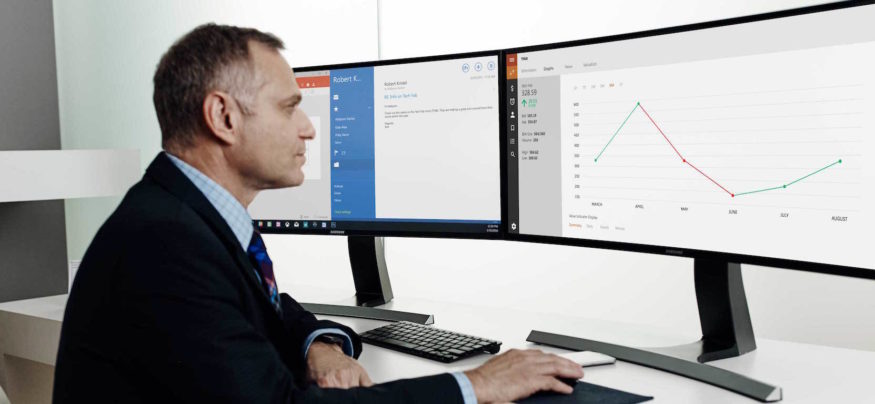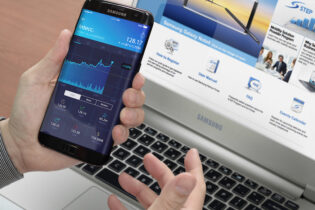When you hear the marketing message “Curved is better,” it’s hard to connect the dots when it comes to the difference between a curved monitor and a flat-panel LED monitor. They perform the same function, have many of the same performance specifications, and, often, cost about the same.
So why would anyone care about curved monitors?
Would taking the Pepsi Challenge compel anyone to switch from flat-panel monitors?
At first blush, to me, it was simply a matter of choice. That was until I bought a curved monitor.
For years, I’ve had multiple monitors on my desktop (at least two or, if possible, three). As studies have shown, having multiple monitors is a productivity enhancer because they allow users to keep multiple applications open at once and eyeball information quickly. And, in the age of social media, it’s particularly useful to have one screen dedicated to news and collaboration feeds.
My eyesight now isn’t what it was when I was a kid, and my older external monitor – a non-Samsung brand I shall not name – was getting tired. After 5 years of service, it had done its job admirably. Also, I wanted a third monitor to make data analysis and report-writing easier. It was time for something new.
I’m a fan of Samsung display products, so the decision to go with Samsung was easy. The next question was size. My Lenovo M93z All-in-One PC has a 24-inch flat-panel display. I considered getting external displays of 27 inches or bigger, but settled on 24 inches, as sometimes there is such a thing as too big.
The next question: Curved or flat?
The answer isn’t as easy as you’d think. Curved monitors have an appeal, as they seem sleek – mostly because they’re different. The marketing material amplifies that perception with notions of immersive displays that are easier on the eyes and provide a greater field of view.
Upon closer inspection, they’re monitors. Just monitors. There’s nothing really different between them and conventional flat-panel displays, particularly when it comes to desktop computing. Would it really matter whether a panel is flat or curved when processing multiple spreadsheets?
In my experience so far, the answer is yes.
The 24-inch curved Samsung CF390 monitors I bought were dramatically different in their functionality, performance, and experience. Sitting at my desk, my forward and peripheral vision is immersed in the display. With the slightest head movement, I’m able to capture information at a glance. And the resolution is simply easier on my eyes, which is good for a person like me who spends 10 or more hours a day in front of a screen.
Surprisingly, one of my larger worries about curved monitors proved groundless – namely, that the curved shape would make them awkward to align. Anyone with two or more monitors knows the challenge of lining multiple displays. Flat panels, no matter their quality, always seem a little disjointed when married up to an AIO PC or another monitor. With their discrete bevels, curved screens are easy to align and have minimal perceived physical gaps.
Lining up the displays wasn’t my only concern about curved monitors. I also worried that the curved shape would force monitors in a series to curve in too close, creating an unnatural workspace. Much to my surprise, the curve of the monitors is so subtle that it would require a dozen or more to complete a circle. Moreover, I was able to manipulate the monitors’ positions back and forth to an angle comfortable for my desk and work needs. Even then, I still perceived the curve, but the monitors don’t appear awkwardly positioned.
Now, back to the Pepsi Challenge. Are curved monitors different enough, on the surface, to warrant choosing them over conventional flat panels? I’m still hard-pressed to answer that question. I probably would have a similar experience with flat-panels, as they share all of the attributes noted above, save the curved shape.
But there’s something inescapably different and better about the curved monitors that makes me not just want to use them, but love them. They just work the way they’re supposed to and provide a better user experience than I’ve had with flat-panel monitors.
When it comes to reselling curved displays, perhaps experience is the key. Rather than trying to sell curved screens on the specifications and look, Samsung resellers may want to consider showing up at a customer’s office with a couple of curved monitors and letting the product do the talking. My brief experience with curved monitors has made me a fan and advocate; perhaps giving customers a hands-on experience will convert them to buyers and evangelists too.
Learn more about Samsung’s curved monitor offerings and their benefits.







